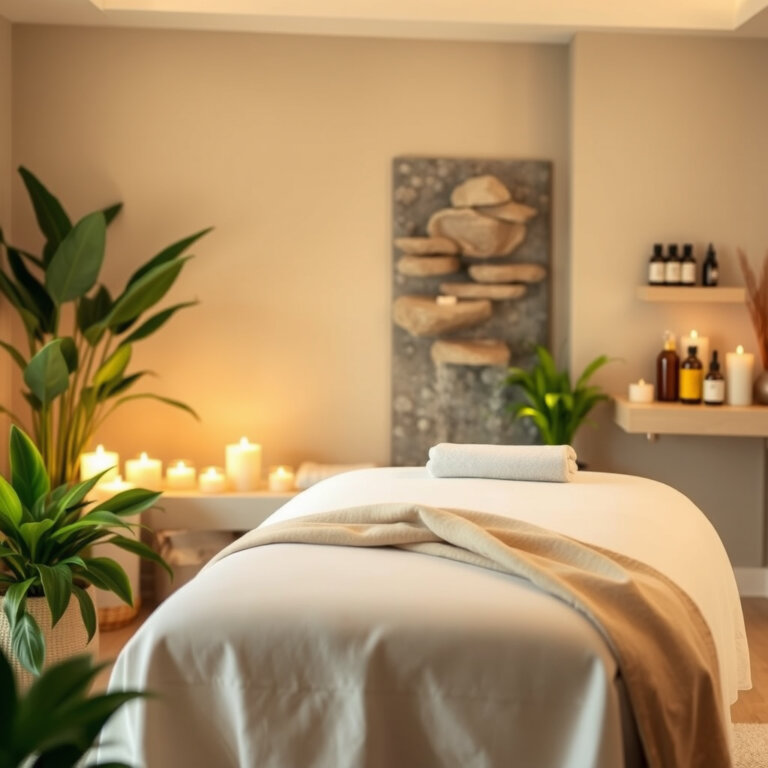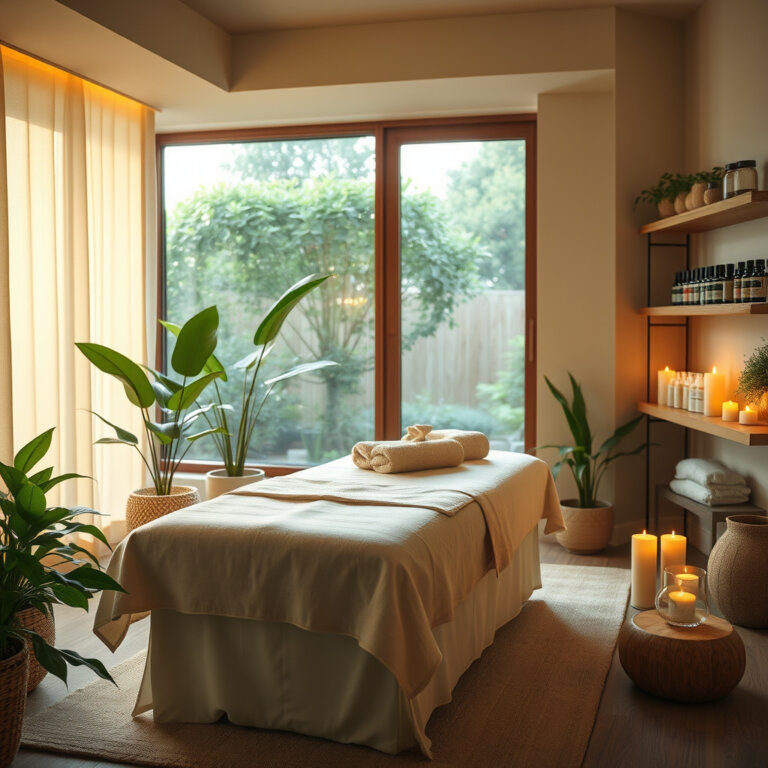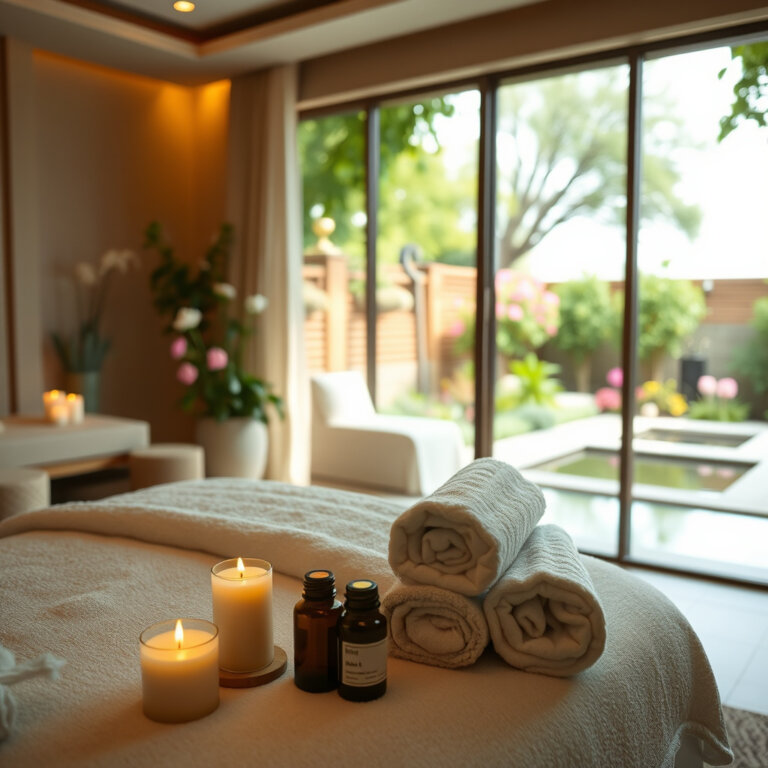Deep tissue massage for stress relief focuses on realigning deeper layers of muscles and connective tissue, helping to alleviate chronic stress and tension.
Are you feeling overwhelmed by the daily grind? Deep tissue massage for stress relief is a powerful solution that can help you unwind and rejuvenate.
In this post, we’ll explore how this therapeutic technique targets the deeper layers of muscle tissue, providing relief from stress and tension.
Stay with us to discover expert tips on choosing the right massage therapist, the science behind deep tissue techniques, and how to integrate this healing practice into your busy life for lasting benefits. 
The Science Behind Stress and Muscle Tension
Stress is an inevitable part of life, and while it can be a motivating force, it often leads to unwanted physical symptoms, notably muscle tension. Understanding the connection between stress and muscle tension is essential for everyone, especially for those seeking effective relief methods such as deep tissue massage for stress relief.
How Stress Affects the Body
When we experience stress, our bodies react in a variety of ways. The brain releases hormones like adrenaline and cortisol, which prepare us for a ‘fight or flight’ response. This physiological reaction is crucial for survival, but when activated frequently, it can lead to chronic tension. The muscles, especially those in the neck, shoulders, and back, tighten as part of this response, creating a cycle of discomfort.
The Role of Muscle Tension
Muscle tension is not just a physical symptom; it can also exacerbate feelings of anxiety and stress. When muscles are tight, they can limit movement and cause pain, which in turn may lead to a more sedentary lifestyle. This combination can create a vicious cycle, making stress management even more challenging. Techniques such as deep tissue massage for stress relief can help break this cycle by relaxing the muscles and promoting a sense of calm.
The Benefits of Massage
Massage therapy, particularly modalities like deep tissue massage, focuses on the deeper layers of muscle tissue. This approach targets chronic tension and can provide significant relief. By applying pressure to specific areas, massage helps improve circulation, reduces inflammation, and enhances relaxation. Many individuals find that regular sessions contribute to better overall well-being and stress management.
Integrating Relaxation Techniques
Incorporating relaxation techniques into your routine can further alleviate stress and muscle tension. Practices such as deep breathing, yoga, and mindfulness meditation complement the benefits of massage. These approaches help ground the mind and body, making it easier to cope with daily stressors. Finding a balance between physical care and mental well-being is crucial in today’s fast-paced world.
Exploring Additional Options
For those seeking comprehensive solutions, exploring body sculpting services near me or spa services for busy professionals can be beneficial. Many spas offer tailored packages designed for stress relief, including affordable spa treatments for couples and spa day packages near me. These services provide a holistic approach to wellness, allowing you to unwind and rejuvenate.
As we navigate the complexities of modern life, being proactive about stress management is vital. Whether through massage, relaxation techniques, or spa experiences, prioritizing self-care can lead to a healthier, more balanced life.
Understanding Deep Tissue Techniques
Deep tissue techniques are more than just a method of massage; they are an essential approach to relieving tension and promoting relaxation in our increasingly stressful lives. As we explore these techniques, it’s important to recognize how they can significantly impact our physical and mental well-being, especially in the context of stress relief.
The Essence of Deep Tissue Techniques
At its core, deep tissue massage focuses on the deeper layers of muscle and connective tissue. Unlike lighter massage techniques, which may only touch the surface, deep tissue methods involve applying sustained pressure to relieve chronic tension. This pressure helps to break up adhesions or knots that often form in response to stress.
The beauty of deep tissue techniques lies in their ability to target specific areas of discomfort. By concentrating on the fascia—the connective tissue surrounding muscles—these methods can effectively alleviate pain and promote overall relaxation. As a result, many individuals find that incorporating deep tissue techniques into their wellness routines can lead to a notable decrease in stress levels.
How Deep Tissue Techniques Work
Understanding how these techniques function can provide insight into their effectiveness. When pressure is applied to tight muscles, it creates a sensation that encourages blood flow to the area. This increased circulation not only helps in healing but also aids in the removal of toxins that may have built up due to stress and tension.
Moreover, deep tissue massage stimulates the parasympathetic nervous system, which is responsible for relaxation. This can lead to a reduction in cortisol levels—the hormone associated with stress—and an increase in serotonin and dopamine, which are neurotransmitters that contribute to feelings of happiness and well-being.
- Increased Blood Flow: Promotes healing and reduces muscle tension.
- Relaxation Response: Activates the body’s natural relaxation mechanisms.
- Relief from Chronic Pain: Targets specific areas of discomfort for lasting relief.
Incorporating Deep Tissue Techniques into Your Routine
For those looking to incorporate deep tissue techniques into their self-care regimen, it’s crucial to find a qualified therapist who understands your unique needs. Many spas now offer specialized services tailored to busy professionals seeking spa services for busy professionals or couples looking for affordable spa treatments for couples.
Additionally, you may find that combining deep tissue massage with other wellness practices enhances its benefits. For instance, pairing a deep tissue session with relaxation techniques such as guided meditation or gentle yoga can amplify the stress-relief effects.
Finding the Right Spa
If you’re considering a visit to a spa for deep tissue massage, look for locations that offer spa day packages near me. These packages often include a variety of treatments designed to promote relaxation and rejuvenation. When exploring options, pay attention to reviews and testimonials to find the best experience for your needs.
In the present landscape of wellness, many individuals are seeking holistic approaches to manage stress and maintain balance in their lives. This has led to a rise in the popularity of non-surgical weight loss options and innovative solutions such as Monjaro weight loss injections. While these may not directly relate to deep tissue massage, they highlight the growing awareness of the importance of comprehensive wellness strategies.
Ultimately, the goal of deep tissue techniques is to foster a sense of relaxation and well-being, allowing individuals to navigate their daily lives with less stress. Embracing these techniques can lead to a healthier, more balanced lifestyle, making them a valuable addition to any wellness routine.
Identifying Your Stress Triggers
Understanding what makes you feel stressed is crucial for managing your well-being. Stress triggers can come in many forms, often manifesting in our daily lives without us even realizing it. By identifying these triggers, you can take steps to mitigate their effects and improve your overall quality of life.
Recognizing Common Stressors
The first step in identifying your stress triggers is to recognize common sources of stress. These can be external factors, such as work pressures, family responsibilities, or financial concerns. They can also be internal, like negative self-talk or perfectionism. Here are some common culprits to consider:
- Work-related pressures, such as deadlines or demanding projects.
- Personal relationships and their associated dynamics.
- Life changes, like moving, changing jobs, or having a baby.
- Health concerns, whether they are physical or mental.
By keeping a journal or note of how you feel in different situations, you can start to pinpoint patterns. Pay attention to your emotions and physical reactions during stressful events.
Physical Symptoms of Stress
Often, stress manifests physically before you even recognize it mentally. Tension in your muscles, headaches, or fatigue can be signs that your body is reacting to stress. For instance, if you notice tightness in your shoulders or back, it might indicate that stress is building up. This is where techniques like deep tissue massage for stress relief can be incredibly beneficial, as they help to alleviate muscle tension and promote relaxation.
Emotional Responses to Stress
It’s important to note how stress affects your mood. Do you feel irritable, anxious, or overwhelmed? Understanding your emotional responses can help you identify your triggers. For example, if you often feel anxious before a meeting, it may be related to your fear of public speaking or the pressure to perform. Recognizing this can empower you to seek support, whether through relaxation techniques or professional help.
Daily Routines and Environmental Factors
Examine your daily routines and environments as well. Are there specific times of day when stress levels peak? This might be during morning rush hours or right before bed. Additionally, consider your surroundings. A cluttered workspace or a noisy environment can contribute to heightened stress. Finding spa services for busy professionals can offer a refuge, allowing you to unwind in a tranquil setting.
Making Connections
Once you’ve gathered insights about your stress triggers, the next step is to make connections. For instance, if you often feel stressed after certain interactions, think about what specifically bothers you. Is it the tone of voice, the topic of conversation, or perhaps feeling unheard? Understanding these nuances helps in developing strategies to cope.
In addition, exploring options like body sculpting services near me or affordable spa treatments for couples can be a great way to incorporate relaxation into your routine, helping to alleviate stress in a holistic manner.
Recognizing and understanding your stress triggers is a journey, but it’s one that can lead to healthier coping mechanisms and a more balanced life. By focusing on both the emotional and physical aspects of stress, you can create a comprehensive approach to managing it effectively.
How Deep Tissue Massage Can Alleviate Stress
Stress is a common companion in our fast-paced lives, manifesting itself in various ways, particularly through muscle tension. When we experience stress, our bodies often respond by tightening muscles, leading to discomfort and pain. This is where deep tissue massage for stress relief comes into play, offering a holistic solution to help restore balance and tranquility.
The Therapeutic Benefits of Deep Tissue Massage
Deep tissue massage focuses on the deeper layers of muscle and connective tissue. It employs techniques that target tension and pain, making it particularly effective for relieving stress-related discomfort. By applying pressure to specific areas, this massage not only helps to release knots in the muscles but also promotes relaxation throughout the body.
One of the key benefits of this type of massage is its ability to stimulate blood flow. Improved circulation can reduce muscle stiffness, promote healing, and enhance overall well-being. As the body relaxes, the mind often follows suit, leading to a decrease in anxiety levels.
Releasing Tension and Stress
During a deep tissue massage, the therapist works methodically, identifying areas of tension that may be contributing to stress. This process can feel intense, but it’s essential to communicate with your therapist about your comfort level. The release of tension in these deeper layers of muscle can lead to a profound sense of relief and well-being.
Moreover, the relaxation response triggered by this massage technique can lower cortisol levels, the hormone associated with stress. With reduced cortisol levels, the body can shift into a more relaxed state, allowing you to feel rejuvenated and centered.
Enhancing Mind-Body Connection
Deep tissue massage encourages a greater awareness of your body and its responses to stress. As you engage in this healing practice, you may find it easier to identify your stress triggers. The therapist’s touch can help you become more attuned to areas where you hold tension, enabling you to develop healthier coping mechanisms moving forward.
Incorporating deep tissue massage into your self-care routine can also complement other wellness practices. Whether it’s yoga, meditation, or even facial treatments for weight loss, these activities can work together to promote relaxation and stress relief.
Finding the Right Spa Services for You
In the current climate, many people seek spa services for busy professionals as a convenient way to unwind. Whether you’re looking for affordable spa treatments for couples or spa day packages near me, it’s essential to find a place that resonates with your needs. Look for establishments that offer a variety of therapeutic options, including deep tissue massage, as part of their services.
By choosing the right location, you can ensure that your experience is both relaxing and restorative. Remember, investing in your well-being is not just about physical health; it encompasses emotional and mental wellness as well.
As you consider your options, think about how body sculpting services near me might also fit into your wellness journey, enhancing both your physical appearance and your state of mind. The integration of different treatments can lead to a more comprehensive approach to stress management and overall health.
In essence, deep tissue massage is a powerful tool in alleviating stress. By addressing the physical manifestations of stress through targeted techniques, you can foster a deeper sense of relaxation and well-being, empowering you to navigate the challenges of everyday life with greater ease.
Finding the Right Therapist for Your Needs
When navigating the world of stress relief and wellness, particularly through therapies like deep tissue massage, finding the right therapist can feel overwhelming. It’s essential to understand that not all therapists are created equal, and what works for one person might not be suitable for another. Your journey towards relaxation and healing begins with choosing someone who aligns with your specific needs and comfort level.
Assessing Your Needs
Before starting your search, take a moment to reflect on what you’re looking for in a therapist. Are you dealing with chronic muscle tension, or perhaps you seek a deeper emotional connection during your sessions? Knowing your priorities can help narrow your options. Consider factors such as:
- Specialization: Some therapists focus on sports injuries, while others may have expertise in relaxation techniques or stress management.
- Techniques: Research various massage techniques. While deep tissue is excellent for muscle tension, other methods might resonate more with your preferences.
- Comfort Level: It’s vital to feel safe and comfortable with your therapist. Pay attention to their communication style and whether it aligns with your expectations.
Research and Recommendations
Once you have a clear understanding of your needs, it’s time to explore your options. Start by asking friends, family, or colleagues for recommendations. Personal experiences can provide valuable insights. Additionally, look for online reviews or testimonials to gauge the reputation of potential therapists.
Don’t hesitate to visit local wellness centers or spas offering body sculpting services near me or spa services for busy professionals. Many establishments have qualified staff who can provide information and recommendations based on their expertise.
Initial Consultations
Once you’ve narrowed down your list, consider scheduling initial consultations. This step allows you to meet potential therapists, ask questions, and assess your comfort level. Inquire about their experience with deep tissue massage and how they approach stress relief. A good therapist will be open to discussing their methods and listening to your concerns.
During these consultations, pay attention to how the therapist interacts with you. Do they seem genuinely interested in your well-being? Are they patient and understanding? The right therapist will create an environment of trust and respect, making it easier for you to relax and benefit from the therapy.
Evaluating the Experience
After a few sessions, take some time to evaluate your experience. Are you feeling more relaxed and less tense? Is the therapist meeting your needs? It’s essential to communicate openly with your therapist about what is working and what isn’t. They are there to help you, and feedback can often lead to adjustments that enhance your experience.
If you find that you’re not achieving the desired results, don’t hesitate to explore other options. There are many professionals out there, and sometimes it takes a little trial and error to find the perfect fit.
In addition to physical therapies, consider exploring other wellness options such as Monjaro weight loss, which can complement your stress relief journey. Treatments can vary widely, and integrating approaches like facial treatments for weight loss or non-surgical weight loss options might also provide additional benefits.
Finding the right therapist is a personal journey that requires patience and self-reflection. By understanding your needs, conducting thorough research, and being open to feedback, you can create a pathway to relaxation that truly resonates with you. Remember, your wellness journey is about finding what makes you feel whole and at peace.
Preparing for Your Deep Tissue Session
When you’re gearing up for a deep tissue massage for stress relief, it’s essential to create an environment that promotes relaxation and prepares your body for the experience. This kind of massage focuses on the deeper layers of muscle tissue, so being well-prepared can enhance its effectiveness and your overall comfort. Here are some thoughtful steps to consider before your session.
Hydrate and Nourish Your Body
Before your appointment, ensure that you are adequately hydrated. Drinking plenty of water in the days leading up to your massage can help your muscles respond better to the treatment. Additionally, eat a light meal beforehand. Avoid heavy foods that could leave you feeling sluggish. A balanced meal will provide you with the energy you need without weighing you down.
Dress Comfortably
Choosing the right attire is crucial. Wear loose, comfortable clothing to your appointment. This will make it easier for the therapist to access the areas that need attention and will keep you feeling relaxed. If you’re unsure about what to wear, don’t hesitate to ask the spa for recommendations when you book your session.
Arrive Early
Arriving a little early allows you to unwind and adjust to the spa environment. This time can be used to fill out any required paperwork and discuss your needs with the therapist. Sharing details about your stress triggers or specific areas of tension can enhance the effectiveness of your treatment. The more your therapist knows, the better they can tailor the session to your individual needs.
Set Your Intentions
Take a moment to reflect on what you hope to achieve with your deep tissue massage for stress relief. Whether you want to alleviate muscle tension, reduce anxiety, or simply enjoy some time for yourself, having a clear intention can help you fully engage in the experience. It’s a chance to take a break from your busy life and focus on your well-being.
Consider Additional Treatments
Incorporating other services can enhance your relaxation experience. Many spas offer spa day packages near me that combine different treatments, such as facial rejuvenation treatments or body sculpting services near me. If you’re also interested in holistic wellness, inquire about options like weight management solutions or non-surgical weight loss options that might complement your overall relaxation journey.
Be Open and Communicative
During your session, maintain open communication with your therapist. If something feels uncomfortable or if you would like more pressure in certain areas, don’t hesitate to speak up. Your comfort is paramount, and providing feedback ensures that the treatment meets your expectations.
By preparing thoughtfully for your deep tissue session, you can create a supportive environment for relaxation and healing. Embrace this time for yourself and enjoy the benefits of the massage in alleviating stress and promoting overall well-being.
Post-Massage Care for Optimal Stress Relief
After indulging in a deep tissue massage, the journey toward lasting stress relief doesn’t end with the last stroke of the therapist’s hands. Instead, it opens a new chapter where self-care becomes paramount. Understanding how to care for yourself post-massage is essential to maximize the benefits you’ve just received.
Hydration: A Key Element
One of the most important steps to take after your session is to hydrate. Deep tissue massage can release toxins stored in your muscles, and drinking water helps flush these out of your system. Aim to drink at least 8 ounces of water right after your massage and continue to hydrate throughout the day. This simple act not only aids in recovery but also keeps your body functioning optimally.
Gentle Movement
While it might be tempting to dive back into your daily routine, consider incorporating gentle movement instead. Light stretching or a leisurely walk can enhance circulation and help maintain the benefits of your massage. This is particularly crucial for those whose stress triggers often manifest physically. Engaging in calming activities, such as yoga or tai chi, can further promote relaxation and help you remain centered.
Rest and Relaxation
After your massage, allow yourself some time to unwind. Whether that means curling up with a good book, enjoying a warm bath, or simply taking a nap, giving your body the opportunity to rest is vital. Creating a peaceful environment can enhance your experience of relaxation. Consider dimming the lights, playing soft music, or even using essential oils to create a soothing atmosphere.
Nourishing Your Body
Fuel your body with nutritious foods following your massage. Opt for meals rich in antioxidants and vitamins to aid in recovery and overall well-being. Foods like leafy greens, berries, nuts, and lean proteins can support your body’s healing processes. Staying mindful of what you eat can also play a role in managing stress levels, especially when combined with other wellness practices.
Integrating Self-Care Practices
Incorporating self-care routines into your life can be incredibly beneficial. Think about scheduling regular massages as part of your wellness plan. Additionally, you might explore other options such as facial treatments for weight loss or body sculpting services near me. These services are tailored to support relaxation and enhance your overall well-being, especially for busy professionals seeking balance.
Listening to Your Body
Finally, pay attention to how your body feels after your massage. It’s natural to experience some tenderness, but if you notice persistent pain or discomfort, consider reaching out to your therapist for advice. They can guide you on how to manage any lingering effects and suggest additional treatments that might be beneficial.
By focusing on these post-massage care strategies, you’ll create a holistic approach to managing stress that extends beyond the massage table. Embrace the moment and the journey towards a more relaxed and balanced life.
Integrating Deep Tissue Massage into Your Busy Lifestyle
In today’s fast-paced world, where stress can easily become a constant companion, finding time for self-care often takes a backseat. However, integrating deep tissue massage for stress relief into your busy lifestyle can be both rewarding and revitalizing. This therapeutic approach not only addresses muscle tension but also offers a holistic way to unwind and reconnect with your body.
Scheduling Your Massage
The first step in making deep tissue massage a regular part of your life is to carve out time in your schedule. Consider setting aside a specific day each month dedicated to self-care. Whether it’s a lunch break or a weekend afternoon, treat this time as sacred. Many spa services for busy professionals offer flexible hours, including early morning or late evening appointments, making it easier to fit into your routine.
Making It Convenient
Look for body sculpting services near me or local spas that provide deep tissue massage, allowing you to reduce travel time. If possible, choose a location close to your workplace or home. This proximity can help you seize opportunities for quick sessions, even if they’re shorter than you’d like. Remember, even a 30-minute session can work wonders when incorporated regularly.
Combining Treatments
To maximize the benefits of your visit, consider pairing your deep tissue massage with other affordable spa treatments for couples or relaxation therapies. For instance, you could combine it with facial treatments for weight loss or skin rejuvenation treatments. This not only enhances your experience but also provides a more comprehensive approach to your wellness.
Creating a Relaxing Environment at Home
Integrating deep tissue massage into your routine doesn’t have to be limited to professional sessions. Create a calming space at home where you can practice relaxation techniques between appointments. Utilize essential oils, soft music, and comfortable seating to cultivate an atmosphere of peace. Even a few minutes of self-massage can help bridge the gap until your next professional session.
Maintaining Wellness Beyond the Massage
Incorporating deep tissue massage is just one part of managing stress effectively. Pair your massage routine with healthy lifestyle choices, such as regular exercise, a balanced diet, and mindfulness practices. For those considering additional support, exploring non-surgical weight loss options or injectable weight loss solutions could also be beneficial. These approaches complement your wellness journey and enhance the overall benefits of your massage sessions.
Incorporating deep tissue massage into your busy lifestyle requires intention and planning, but the rewards—both physical and mental—are well worth the effort. By making small adjustments and prioritizing your well-being, you can enjoy the profound benefits of this therapeutic practice, allowing you to live a more balanced and relaxed life.

At Best and Beyond Spa, Day and Davilla are dedicated professionals passionate about wellness and beauty. With expertise in spa day treatments, couples massages, and senior wellness, they provide high-quality, personalized care in a relaxing environment. Their mission is to help clients feel rejuvenated, refreshed, and truly cared for.













